Origins
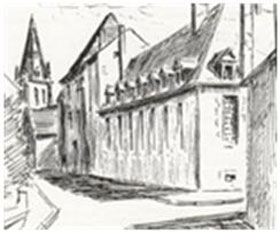 La Flèche (1636 -)
La Flèche (1636 -)In May 1636, Marie de la Ferre and Anne Foureau formed a community at the Hotel-Dieu with three servants of the poor already on site. Thus began the Congregation of the Daughters Hospitallers of St. Joseph.
In 1793, at the time of the French Revolution, the Hotel-Dieu was transformed into a prison and the Hospitallers of Saint Joseph were expelled. In 1802, they resumed care for the sick in the former convent of the Visitandines which became a hospital where they worked until 1993. But in 1985, they left their hospital quarters and moved into a new home built close to the hospital.
Today The LaFleche community is the administrative office of the Holy Family region. The engaged, according to their possibilities in pastoral health care ministry, visiting isolated persons and the poor within their partnership with the parish and the hospital chaplaincy. The Congregation archives have been deposited in the Departmental Archives of Angers.
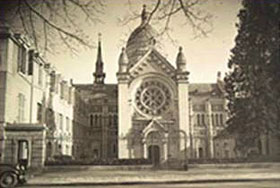 Laval (1650-2011)
Laval (1650-2011)In 1650, eight Hospitallers of St. Joseph arrived in Laval where a former chaplaincy had been transformed into a Hotel-Dieu. The community developed normally, attracting young women. In 1659, three Sisters from Laval were chosen for the first community of Hospitallers of St. Joseph in Montreal in New France. During the French Revolution, the fate of the Hospitallers was about the same as that of the Sisters in Bauge. In spite of their poverty and distress, they offered refuge to the eight companions who had been expelled from LaFleche and Beaufort.
In 1974, a modern 560 bed hospital was opened and the patients from the old Hotel-Dieu were transferred. Eight Sisters worked in this New Health Care Centre for a few years, the last leaving in 1987.
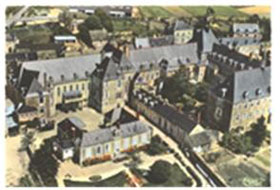 Baugé (1650-1991)
Baugé (1650-1991)The construction of the hospital began in 1643 by Marthe de la Beausse, a celibate without wealth. In 1650, she recruited Anne de Melun, princess of Epinay who passed incognito under the borrowed name of “Sister de la Haye”. In November 1650, three Daughters of Saint Joseph from LaFleche came to the unfinished hospital, which made great progress, thanks to the generosity of “Sister de la Haye”.
During the french Revolution, the Sisters were forbidden to wear the habit, but they continued their service in the hospital, but not in the boarding school. Opened again in 1810, the boarding school closed in 1906. In 1991, the last sister retired and the community left Beaugé.
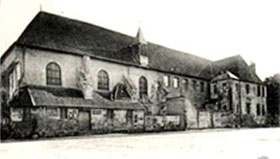 Moulins (1651-1793)
Moulins (1651-1793)While studying in LaFleche, Gabriel Girault de Moulins came to know Jerome Le Royer and admired the good management of the hospital. Having become a priest, he wanted the Hospitallers of Saint Joseph to come to his native city. However, the city council was very reticent and only accepted with specific conditions: their hospital would only serve female patients and the sisters would be in charge of an orphanage for girls from 3 – 12 years of age.
Jerome Le Royer recognized this need and signed the contract. Subsequently, other houses in France and America would open orphanages and boarding schools.
In June 1651, Marie de la Ferre and four companions established a charitable work in Moulins under very difficult conditions. Marie de la Ferre died on July 28, 1652 a victim of her charitable work among the plague-stricken population. However, with time, the situation was restored to normal and the community and works of the Hospitallers of Saint Joseph developed.
The French Revolution put an end to this expansion and in 1793, the Sisters were expelled from Moulins, never to return.
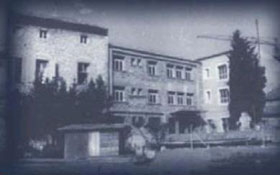 Nîmes (1663-2003)
Nîmes (1663-2003)When the Hospitallers of Saint Joseph, among whom was Jeanne Le Royer, arrived in Nimes on May 18, 1663 they found the hospital in very poor condition. They quickly restored order, cleanliness and progress. The Nimes community established a hospital at Avignon in 1672, at l’Isle-sur-Sorgues in 1685 and at Rivieres-des-Teyrargues in 1698. During the French Revolution, the Hospitallers in Nîmes "condemmed to a permanent prison in their convent", continued to care for the sicvk and admitted novices.
However, the community was expelled from Hotel-Dieu in 1904. Subsequenly, they opened a polyclinic which remained opened until 1975, and a dispensary from 1955 - 1981. Thereafter the Sisters became engaged in various apostolates. Their convent chapel on its original site located in the center of the city, welcomed groups of various ages. In addition to their hospitality services, the Sisters were engaged in three principal ministries : pastoral service to the home-bound, participation in chaplaincy services to the students and involvement in an agency caring for the poor. In 2003, after 340 years of presence in Nîmes, the RHSJ left this historic city in Southern France due to lack of Sisters who could continue to serve there.
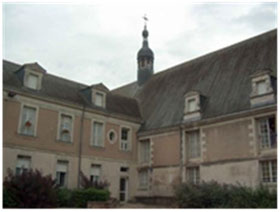 Beaufort (1671-1963)
Beaufort (1671-1963)At the request of Monsignor Henri Arnault, Bishop of Angers, the Hospitallers of Saint Joseph arrived at Beaufort in May, 1671. The city leaders were not too favorable to their coming , since they did not see the need to change what had existed for such a long time. The foundresses entered the hospital which was “ nothing but a cesspool where the sick and even the indigent refused to enter…”. Moreover, they had to tend to the well being of a dozen orphans. Sister “de la Haye”, Princess of Epinay, came from Bauge to help them and with various gifts, they undertook the construction. The city council finally contributed to it.
In 1794, the Sisters were dispersed, imprisoned, threatened with deportation. They returned to Beaufort in 1795. A community of Religious Hospitallers of Saint Joseph represented the Congregation in this city until 1964.
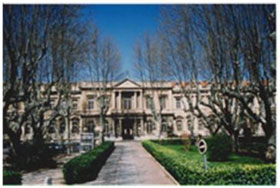 Avignon (1672-1911)
Avignon (1672-1911)Solicited by the people of Avignon, the Hospitallers of Saint Joseph from the Nimes community accepted to come to the papal city in February 1672 to “stem the disorder which was rampant in this “splendid hospital” established in the XIV century. Like most of the other foundations, the beginnings were very difficult, but the Hotel-Dieu of Avignon was transformed very rapidly.
In 1685,the Sisters were even able to respond to a request for a foundation in L’Isle-sur-Sorgue. The Sisters in Avignon suffered greatly during the Revolution. Dispersed for many years they returned after the turmoil. However, in 1910, political problems necessitated the Hospitallers to leave Avignon. They founded a hospital in Lobbes, Belgium.
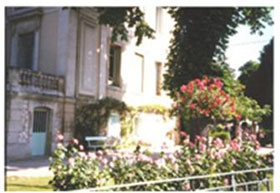 Isle-sur-Sorgues (1685-2004)
Isle-sur-Sorgues (1685-2004)The three founding Sisters, one from Nimes and two from Avignon. Arrived on November 16, 1685 in this small town of 6000 inhabitants who gave them a warm reception, and rather exceptionally, they even provided them with a house and a chapel. They did not escape deprivation, since each one of them came with a modest income and cared for the sick without cost as prescribed by the Constitutions. Expansion of the hospital was made possible by the generosity of benefactors.
In 1792, an order was received to close the convent and the community of 16 Sisters was dispersed. In 1825, four Hospitallers of Saint Joseph of Avignon established themselves in L’Isle-Sur-Sorgues, and Hotel Dieu was restored. At the beginning of the XXI century, a small group of Sisters maintained an active presence of the Congregation with their regular participation in the local community, the parish, charitable organizations and the chaplaincy of the Hospital. They left Isle-Sur-Sorgues in 2004.
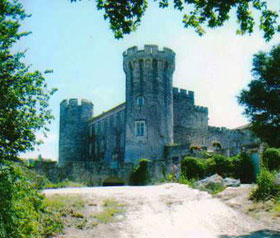 Rivière-de-Teyrargues (1698-1789)
Rivière-de-Teyrargues (1698-1789)The Marquise de la Porte, a lady from Rivieres-de-Teyrargues, decided to build a hospital for the 700 inhabitants of this small community and to entrust it to the Hospitallers of Saint Joseph of Nimes. Her insistent steps resulted in overcoming the resistance of the Sisters.
In November 1798, the three foundresses came to this small village where there was nothing to receive them. Madame la Marquise received them in her chateau de Teyrargues where they remained for 17 years.
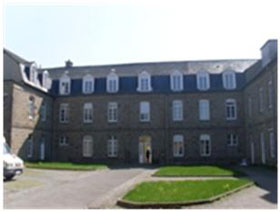 Ernée (1819-2010)
Ernée (1819-2010)In 1819, a community of Hospitallers Canonesses of Saint Augustin, who administered the local hospital in Ernee for approximately 200 years, was reduced to a small number of aging sisters. The Bishop suggested that this congregation become affiliated with the Hospitallers of Saint Joseph in Laval. This affiliation agreement was signed on May 24, 1819.
After a year of novitiate, the Canonesses took vows as Religious Hospitallers of St. Joseph.
Beaupreau (1904-)
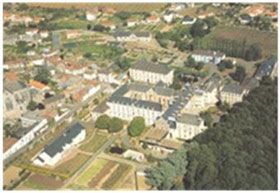 Father Michel Rabouan, pastor of Saint Martin in Beaupreau wanted to build a modest hospital for his parish. He was supported by Victor Brevet, a layman. Thus, in 1832 after several unsuccessful attempts with two neighboring Congregations, he established the Saint Martin community in Beaupreau, inspired by the constitutions of the Religious Hospitallers of Saint Joseph in Bauge.
Father Michel Rabouan, pastor of Saint Martin in Beaupreau wanted to build a modest hospital for his parish. He was supported by Victor Brevet, a layman. Thus, in 1832 after several unsuccessful attempts with two neighboring Congregations, he established the Saint Martin community in Beaupreau, inspired by the constitutions of the Religious Hospitallers of Saint Joseph in Bauge.This young institute focussed on care of the sick, the elderly, handicapped persons and sick priests. This community was only affiliated with the RHSJ in 1904.
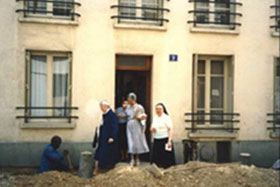 Paris (1967-1994)
Paris (1967-1994)In September 1965, Sister Pauline Maille, Provincial Superior and Sister Helen Lamarre, Director of Formation temporarily located at 2, rue Denis Papin, Angers. The other members of the Council joined them within a few weeks. In 1966, the formation house in Laval was erected as the Provincial House.
To respond to the formation needs and facilitate hospitality, the Provincial House and formation moved to 9, rue Lemercier, Paris.
In 1994, since there were no longer persons in formation, the provincial house left Paris and moved to La Fleche.
